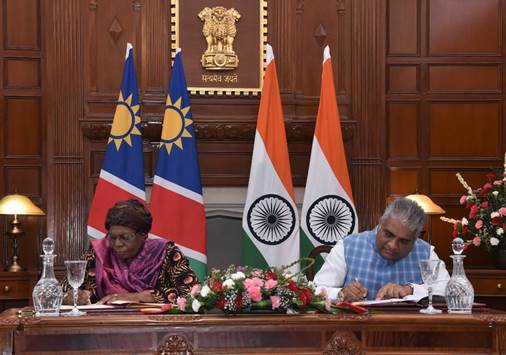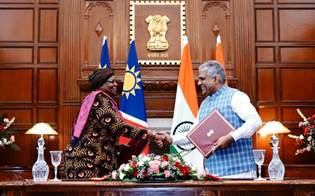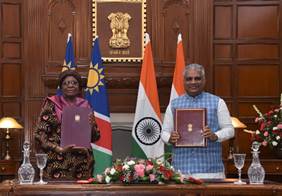Ministry of Environment, Forest and Climate Change
India-Namibia sign an MoU on wildlife conservation and sustainable biodiversity utilization
MoU focusses on Wildlife conservation and sustainable biodiversity utilization between the two countries
Cheetah reintroduction project in India to restore historic evolutionary balance contributing to global conservation efforts
प्रविष्टि तिथि:
20 JUL 2022 12:59PM by PIB Delhi
Government of India and Government of the Republic of Namibia have entered into a Memorandum of Understanding (MoU) on wildlife conservation and sustainable biodiversity utilization, today, for establishing the cheetah into the historical range in India.



The MoU facilitates development of a mutually beneficial relationship to promote wildlife conservation and sustainable biodiversity utilization based on the principles of mutual respect, sovereignty, equality and the best interest of both India and Namibia.
The main thrust areas of MoU are:
- Biodiversity conservation with specific focus on conservation and restoration of cheetah in their former range areas from which they went extinct,
- Sharing and exchange of expertise and capacities aimed at promoting cheetah conservation in two countries,
- Wildlife conservation and sustainable biodiversity utilization by sharing good practices in
- Technological applications, mechanisms of livelihood generation for local communities living in wildlife habitats, and sustainable management of biodiversity.
- Collaboration in areas of climate change, environmental governance, environmental impact assessments, pollution and waste management and other areas of mutual interest.
- Exchange of personnel for training and education in wildlife management, including sharing of technical expertise, wherever relevant.
Cheetah has a very special significance for the national conservation ethic and ethos. Bringing the cheetah back to India would have equally important conservation ramifications. Cheetah restoration will be part of a prototype for restoration of original cheetah habitats and their biodiversity, helping to stem the degradation and rapid loss of biodiversity.
Among large carnivores, conflict with human interests are lowest for cheetahs, as they are not a threat to humans and usually do not attack large livestock. Bringing back a top predator restores historic evolutionary balance resulting in cascading effects on various levels of the ecosystem leading to better management and restoration of wildlife habitat (grasslands, scrublands and open forest ecosystems), conservation of cheetah’s prey and sympatric endangered species and a top-down effect of a large predator that enhances and maintains the diversity in lower trophic levels of the ecosystems.
The main goal of Cheetah reintroduction project in India is to establish viable cheetah metapopulation in India that allows the cheetah to perform its functional role as a top predator and provides space for the expansion of the cheetah within its historical range thereby contributing to its global conservation efforts.
Surveys for 10 sites were conducted between 2010 and 2012. From the potential sites evaluated for the feasibility of establishing cheetah populations in India based on IUCN guidelines for reintroductions that consider species viability according to demography, genetics and socio-economics of conflict and livelihoods, Kuno National Park in the state of Madhya Pradesh was considered ready for receiving cheetah with the least management interventions since a lot of investments had been done in this Protected Area for reintroducing Asiatic lions.
Cheetah presence locations from Southern Africa (South Africa, Namibia, Botswana and Zimbabwe) were used along with relevant eco-climatic covariates to model equivalent niche space in India using Maximum Entropy Models. The analysis shows that the climatic niche of the cheetah from southern Africa exists in India with Kuno National Park having a high probability of cheetah habitat suitability.
The action plan for cheetah translocations in Kuno National Park has been developed in compliance with IUCN guidelines and considering site assessment and prey density, current cheetah carrying capacity of Kuno National Park, among other criteria.
While the current carrying capacity for Kuno National Park is a maximum of 21 cheetahs, once restored the larger landscape can hold about 36 cheetahs. The carrying capacity can be further enhanced by including the remaining part of the Kuno Wildlife Division (1,280 sq km) through prey restoration.
Financial and administrative support to the cheetah reintroduction programme in India would be provided by MoEF&CC through NTCA. Participation of Government and corporate agencies through Corporate Social Responsibility (CSR) would be encouraged for additional funding at the State and Central level. The Wildlife Institute of India (WII), national and international carnivore/cheetah experts/agencies would provide technical and knowledge support to the programme.
The officials of the MoEF&CC, NTCA, WII, State Forest Departments would be sensitized to ensure the success of cheetah reintroduction in India, through capacity building programs in Cheetah conservation reserves of Africa. In addition, the Cheetah managers and biologists from Africa would be invited to impart training of Indian counterparts.
The Kuno National Park management will be responsible for monitoring which is essential for protection and management while a cheetah research team will monitor for research. Various outreach & awareness programmes will be conducted to encourage participation of local villagers. Sarpanches (village head men), local leaders, teachers, social workers, religious figures and NGOs would be provided with a better stake in the conservation. Awareness programmes are also planned for schools, colleges and villages sensitizing people about the conservation and various schemes available with the forest department. Public awareness campaigns are underway for the local communities with a local mascot named “Chintu Cheetah”. The Chief Minister of Madhya Pradesh has asked all state officials and elected members of the state assembly from the constituencies around Kuno National Park to disseminate information regarding the cheetah-human interface.
As per the directions of the Supreme Court of India in 2020, the cheetah reintroduction in India is being overseen by the National Tiger Conservation Authority (NTCA), Ministry of Environment, Forest and Climate Change (MoEF&CC), guided and directed by the committee of experts designated by the Supreme Court of India.
*****
HS/PD/IG
(रिलीज़ आईडी: 1842971)
आगंतुक पटल : 5723
इस विज्ञप्ति को इन भाषाओं में पढ़ें:
Urdu
,
हिन्दी
,
Marathi
,
Bengali
,
Manipuri
,
Punjabi
,
Gujarati
,
Odia
,
Tamil
,
Telugu
,
Kannada
,
Malayalam